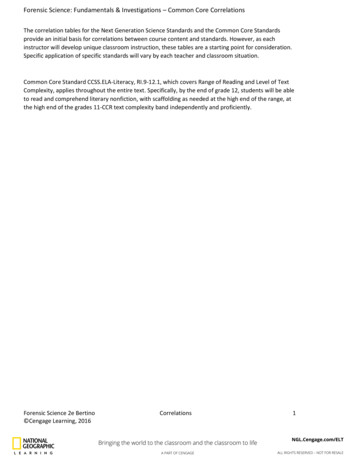
Transcription
1Forensic Science: Fundamentals & Investigations, 2eChapter 4All rights ReservedCengage/NGL/South-Western 2016
Chapter 4 A Study of Fibers andTextilesBy the end of this chapter you will be able to:4.1 Identify and describe common weavepatterns of textile samples.4.2 Compare and contrast various types offibers through physical and chemical analysis.4.3 Describe principal characteristics ofcommon fibers used in their identification.4.4 Apply forensic science techniques toanalyze fibers.2Forensic Science: Fundamentals & Investigations, 2eChapter 4All rights ReservedCengage/NGL/South-Western 2016
Chapter 4Vocabularyooooooo3amorphouscrystallinedirect transferfibermineral fibermonomernatural fiberoooooooForensic Science: Fundamentals & Investigations, 2eChapter 4polymersynthetic fibersecondary transfertextilewarpweftyard (thread)All rights ReservedCengage/NGL/South-Western 2016
IntroductionoooFibers are used to create a link betweencrime and suspect.not specific to a single person.trace evidence. o4Direct transferSecondary transferCollecting fibers within 24 hours is critical.(95% lost)Forensic Science: Fundamentals & Investigations, 2eChapter 4All rights ReservedCengage/NGL/South-Western 2016
Collectingo5use tape,forceps, avacuum, or asticky lint roller.Forensic Science: Fundamentals & Investigations, 2eChapter 4All rights ReservedCengage/NGL/South-Western 2016
Sampling and TestingooooShedding—common form of fiber transferMicroscopic Analysis for natural fibersInfrared, florescent, refraction spectroscopycan show chemical structureDestructive Testing Methods 6Burn AnalysisChemical AnalysisForensic Science: Fundamentals & Investigations, 2eChapter 4All rights ReservedCengage/NGL/South-Western 2016
Burn AnalysisCompare fibers found on different suspectswith those found at the crime scene7Forensic Science: Fundamentals & Investigations, 2eChapter 4All rights ReservedCengage/NGL/South-Western 2016
EvaluatingoThe value of fiber evidence depends on itspotential uniqueness. 8Type of fiberFiber colorNumber of fibers foundWhere the fiber was foundForensic Science: Fundamentals & Investigations, 2eChapter 4All rights ReservedCengage/NGL/South-Western 2016
Evaluating 9(continued)Textile from whichthe fiber originatedMultiple fibertransfersType of crimecommittedTime between crimeand discovery of fiberForensic Science: Fundamentals & Investigations, 2eChapter 4All rights ReservedCengage/NGL/South-Western 2016
Natural Fibersoo10from animals, plants, and minerals thatare mined from the ground.composed of polymers, or long,repeating molecules.Forensic Science: Fundamentals & Investigations, 2eChapter 4All rights ReservedCengage/NGL/South-Western 2016
Natural FibersCotton fibers are the plant fibers most commonly usedin textile materialsThe animal fiber most frequently used in theproduction of textile materials is wool, and the mostcommon wool fibers originate from sheep.Forensic Science: Fundamentals & Investigations, icle naturalfibersabsorb.htmChapter 4
Animal Fibersoo12Three sources: hair, fur, and webbing.made of proteins.Forensic Science: Fundamentals & Investigations, 2eChapter 4All rights ReservedCengage/NGL/South-Western 2016
woven wool textileoooooWool / cashmere sheepMohair goatsAngora rabbitsHair from alpacas, llamas, and camelsSilk from caterpillar cocoons Bombyx mori(longer fiber does not shed easily)13Forensic Science: Fundamentals & Investigations, 2eChapter 4All rights ReservedCengage/NGL/South-Western 2016
Plant Fibersoooooo14polymer cellulose.- glucose units.can absorb water.insoluble in water.resistant to damage from harsh chemicals.only dissolved by strong acids.can be common at crime scenes becausethey become brittle over timeForensic Science: Fundamentals & Investigations, 2eChapter 4All rights ReservedCengage/NGL/South-Western 2016
Plant fibers (seed):oCotton—most common textileplant fiber (picture)o Leaf fibers15 Manila- from abaca plant leaves (banana family) SisalForensic Science: Fundamentals & Investigations, 2eChapter 4All rights ReservedCengage/NGL/South-Western 2016
oFruit fibers Coir fiber coconutso16oStem fibers Flax (linen), jute, andhempIt is relativelywaterproof.Forensic Science: Fundamentals & Investigations, 2eChapter 4All rights ReservedCengage/NGL/South-Western 2016
oMineral fibersFiberglass—afibrous form ofglassUsed to insulatebuildingsoAsbestos—acrystalline structureNo longer used forbuilding materialo17Forensic Science: Fundamentals & Investigations, 2eChapter 4All rights ReservedCengage/NGL/South-Western 2016
Synthetic (Manufactured) Fiberso50% fabrics man made joining many monomers together to formpolymers.Rayon, acetate, nylon, acrylics, and polyestersSynthetic Fibers under amicroscope18Forensic Science: Fundamentals & Investigations, 2eChapter 4All rights ReservedCengage/NGL/South-Western 2016
Regenerated Fibers ( from cellulose):oRayon oCelenese oCellulose chemically combined with acetateFound in many carpetsPolyamide nylon 19Most common in this groupImitates natural fibers, but strongerCellulose combined with three acetate unitsBreathable and lightweightUsed in performance clothingForensic Science: Fundamentals & Investigations, 2eChapter 4All rights ReservedCengage/NGL/South-Western 2016
Synthetic Polymer FibersoPetroleum baseoFibers produced spun into yarnsoNo internal structures- under microscopeshow uniform diameters20Forensic Science: Fundamentals & Investigations, 2eChapter 4All rights ReservedCengage/NGL/South-Western 2016
oPolyester “Polar fleece” (Polyethylene terephthalate (PET))- First made to mimic wool Wrinkle-resistant Not easily broken down by light or concentratedacid Added to natural fibers for strengthoNylon Easily broken down by light and concentrated acid Otherwise similar to polyester21Forensic Science: Fundamentals & Investigations, 2eChapter 4All rights ReservedCengage/NGL/South-Western 2016
oAcrylic Inexpensive Tends to “ball” easily Substitute for artificial wool or fur omade from a polymer (polyacrylonitrile)Olefins High performance- wallpaper, rope, vehicle interiors Quick drying/ Resistant to wear Made from polyolefin (polypropyleneor polyethylene)22Forensic Science: Fundamentals & Investigations, 2eChapter 4All rights ReservedCengage/NGL/South-Western 2016
Comparison of Natural andSynthetic Fibersooo23Synthetic fibers are stronger than thestrongest natural fibers.Manufactured fibers are not damaged bymicroorganisms.Manufactured fibers can deteriorate in brightsunlight and melt at a lower temperature thannatural fibers.Forensic Science: Fundamentals & Investigations, 2eChapter 4All rights ReservedCengage/NGL/South-Western 2016
Yarnsooo24Fibers too short in their raw state to be usedto make textiles may be spun together tomake yarns.Very thin yarns are often called threads.For identification analyze twist direction ofyarn.Forensic Science: Fundamentals & Investigations, 2eChapter 4All rights ReservedCengage/NGL/South-Western 2016
25Forensic Science: Fundamentals & Investigations, 2eChapter 4All rights ReservedCengage/NGL/South-Western 2016
Textilesoo26Weaving consists of arranging lengthwisethreads (the warp) side-by-side and closetogether.Cross wise threads (the weft) are then wovenback and forth in one of several differentpatterns.Forensic Science: Fundamentals & Investigations, 2eChapter 4All rights ReservedCengage/NGL/South-Western 2016
27Forensic Science: Fundamentals & Investigations, 2eChapter 4All rights ReservedCengage/NGL/South-Western 2016
Comparison of Natural andSynthetic FibersVisual Diagnostics of Some Common Textile Fibersunder Magnification28Forensic Science: Fundamentals & Investigations, Chapter 4
Textiles (continued)oThe ways that fabrics differ include: oo29Weave patternThread countTwo plyFiber identification using various microscopes, gaschromatography, and mass spectrometers ispossible.Fiber identification provides class evidence only andshould not be used to convict someone.Forensic Science: Fundamentals & Investigations, 2eChapter 4All rights ReservedCengage/NGL/South-Western 2016
30Forensic Science: Fundamentals & Investigations, 2eChapter 4All rights ReservedCengage/NGL/South-Western 2016
31Forensic Science: Fundamentals & Investigations, 2eChapter 4All rights ReservedCengage/NGL/South-Western 2016
Can you identify the types of fibers shown?Think About It (1) Which samples are natural fibers?(2) Which samples are synthetic fibers?(3) What characteristics can be used to identify fiber samples?
Types of Fibers - KeyAcrylic YarnCotton YarnNylon RopePolyester YarnRayon RopeWool Yarn
Summaryoooo34Fibers are a form of class evidence used by crime-sceneinvestigators; they are a form of trace evidence.Fiber evidence may be gathered using tape, forceps, avacuum, or a sticky lint roller.Forensic scientists will try to determine the type of a fiber,its color, how many fibers of each kind were found, wherethey were found, what textile the fiber came from, andwhether there were transfers of multiple types of fibers.Fibers may be analyzed using polarized light microscopy,infrared spectroscopy, burn tests, or tests for solubility indifferent liquids.Forensic Science: Fundamentals & Investigations, 2eChapter 4All rights ReservedCengage/NGL/South-Western 2016
Summary (continued)ooooo35Fibers may be classified as natural or synthetic.Natural fibers include animal hair; plant fibers fromseeds, fruit, stems, or leaves; and mineral fibers.Synthetic fibers include regenerated or modifiednatural fibers as well as synthetic polymer fibers.Fibers are spun into yarns that have specificcharacteristics.Yarns are woven, with different weave patterns, intotextiles.Forensic Science: Fundamentals & Investigations, 2eChapter 4All rights ReservedCengage/NGL/South-Western 2016
Forensic Science: Fundamentals & Investigations, 2e 1 Chapter 4 All rights Reserved Cengage/NGL/South-Western 2016










